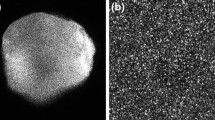Abstract
In this paper, based on the optical properties of speckle, the correlation between laser speckle image and nanoparticles is analyzed, and a method to measure the flow velocity of nanofluids using speckle image is proposed. The influence of nanofluids type, temperature and concentration on speckle image was investigated. On the basis of grating spatial filtering, based on PIV (Particle Image Velocimetry) cross-correlation algorithm and optical flow field algorithm, the principle of gray conservation and interpretation window are introduced to extract the spectral characteristic curve of speckle image signal. Considering the interference of the environment noise, the wavelet packet decomposition method is proposed to separate the low-frequency features and obtain the peak frequency of the signal. The static and dynamic speckle images are analyzed by establishing a circular tube flow measurement system with laser speckle circulation to verify the rationality and feasibility of the velocity measurement method. The experimental results show that the speckle image of CuO nanofluids in static experiment is better than that of Al2O3 nanofluids, and increasing temperature has no obvious effect of improving image quality. The average relative error between the calculated results and the measured results is 4.9 and 4.5%, which proves that this method is reasonable and feasible.
















Similar content being viewed by others
REFERENCES
Motevasel, M., Solaimany Nazar, A.R., and Jamialahmadi, M., J. Therm. Anal. Calorim., 2019, vol. 135, p. 133. https://doi.org/10.1007/s10973-018-7314-8
Eastman, J.A., Choi, U.-S., Li, S., Thompson, L.J., and Lee, S., MRS Proc., 1996, vol. 457, p. 3. https://doi.org/10.1557/PROC-457-3
Wang, X. and Xu, X., J. Thermophys. Heat Transfer, 2012, vol. 13, no. 13, p. 474. https://doi.org/10.2514/2.6486
Eastman, J.A., Yu, W., Choi, U.-S., Thompson, L.J., and Li, S., Appl. Phys. Lett., 2001, vol. 78, no. 6, p. 718. https://doi.org/10.1063/1.1341218
Alimenti, F., Bonafoni, S., Gallo, E., Palazzi, V., Gatti, R.V., Mezzanotte, P., Roselli, L., Zito, D., Barbetta, S., and Corradini, C., IEEE Trans. Geosci. Remote Sens., 2020, vol. 58, no. 7, p. 5195. https://doi.org/10.1109/TGRS.2020.2974185
Kazuya Nakano, Yuta Aoki, Ryota Satoh, Akira Hoshi, Hiroyuki Suzuki, and Izumi Nishidate, Proc. SPIE 9715, Optical Diagnostics and Sensing XVI: Toward Point-of-Care Diagnostics, San Francisco, CA, 2016, p. 971515. https://doi.org/10.1117/12.2212417
Zhang Jun, Chen Liujun, Xu Qi, Wu Yungang, and Zhang Long, J. Aeronaut. Power, 2017, vol. 32, no. 06, p. 1289. https://doi.org/10.13224/j.cnki.jasp.2017.06.002
Soares, R.R., Barbosa, H.C., Braga, R.A., Botega, J.V.L., and Horgan, G.W., Flow Meas. Instrum., 2013, vol. 30, p. 90. https://doi.org/10.1016/j.flowmeasinst.2013.01.008
Masayasu Shimura and Mamoru Tanahashi, J. Combust. Soc. Jpn., 2019, vol. 61, no. 197, p. 231. https://doi.org/10.20619/jcombsj.61.197_231
Han, L., Wang, H., Liu, X., Xie, R., and Fu, C., Sensors, 2019, vol. 19, no. 12, p. 2702. https://doi.org/10.3390/s19122702
Adrian, R.J., Exp. Fluids, 2005, vol. 39, no. 2, p. 159. https://doi.org/10.1007/s00348-005-0991-7
Park, J.H., Choi, W., and Sang, J.L., Ultrasonics, 2020, vol. 104, p. 106093. https://doi.org/10.1016/j.ultras.2020.106093
Contado, E., Júnior, R.A.B., Barbosa, H.C., Reis, R.O., and Prabhu, R., Theor. Appl. Eng., 2020, vol. 5, p. 1. https://doi.org/10.31422/taae.v4i4.33
Adrian, R.J. and Lyilo, C.S., Appl. Opt., 1985, vol. 24, p. 44. https://doi.org/10.1364/AO.24.000044
Peisen, L., Basis of Speckle Statistical Optics, Science Press, 1987, pp. 5−56, pp. 91−103.
Ming Qian, Xiao Wu Ni, Jian Lu, and Zhong Hua Shen, Key Eng. Mater., 2008, vol. 86, p. 1111. https://doi.org/10.4028/www.scientific.net/KEM.364-366. 1111
Gong, J.M., Yang, H., Lin, S.H., Li, R., and Zivkovic, V., Powder Technol., 2018, vol. 324, no. 15, p. 76. https://doi.org/10.1016/j.powtec.2017.10.041
Zhang, D. and Liu, R., Int. J. Opt., 2019, vol. 2019. no. 9, p. 1. https://doi.org/10.1155/2019/1097292
Sun, K., Zhang, J., Shi, W., and Guo, J., Energies, 2019, vol. 12, no. 17, p. 3242. https://doi.org/10.3390/en12173242
Bettayeb, F., Haciane, S., and Aoudia, S., NDT&E Int., 2005, vol. 38, no. 6, p. 478. https://doi.org/10.1016/j.ndteint.2004.12.003
Feng Zhen and Ma Qishuang, Laser Infrared, 2010, vol. 40, no. 3, p. 315, https://doi.org/10.3724/SP.J.1087.2010.02819
Kan, Z., Shao, F., and Li, Q., Chin. J. Sens. Actuators, 2012, vol. 25, no. 5, p. 609. https://doi.org/10.3969/j.issn.1004-1699.2012.05.011
Gao, H., Fan, B., and Chang, Q., Rev. Sci. Instrum., 2019, vol. 90, no. 7, p. 075002. https://doi.org/10.1063/1.5100184
Xu, C., Zhou, B., Yang, D., Tang, G., and Wang, S., Meas. Sci. Technol., 2008, vol. 19, no. 2, p. 211. https://doi.org/10.1088/0957-0233/19/2/024005
ACKNOWLEDGMENTS
This work was supported by National Natural Science Foundation of China under Contract (nos. 51966005, 52069010).
Author information
Authors and Affiliations
Corresponding authors
Ethics declarations
The authors of this work declare that there are no conflicts of interest regarding the publication of this paper.
SUPPLEMENTARY MATERIALS WAVELET PACKET TRANSFORM DETAILS
SUPPLEMENTARY MATERIALS WAVELET PACKET TRANSFORM DETAILS
Firstly, the coefficients of orthogonal low-pass filter and high pass filter are defined as ls and hs, respectively, and the following conditions must be met:
If the sequence of wavelet packets is defined as: \(\{ {{T}_{s}}(t){\text{|}}s \in {{N}_{1}}\} \), then there are:
The scaling function of wavelet packet function is:
Where the frequency response of ls is H0(w), as follows:
Then, from formula (2), we can get:
It can be seen from the above formula that on the left side of the formula, it constitutes a set of normal orthogonal bases of L2(R).
The continuous time signal of discrete sampling signal is given as follows:
where e0.0,k represents the k-th component of the discrete sampling signal. Formula (6) is similar to Shannon’s theorem. Then from formula (5), we can get:
Formula (7) is combined with formula (6), and the dissolving formula (6) is as follows:
In the above formula, let e1,0,k be:
The formula (9) is further substituted into (8) to simplify:
Substitute the following formula into formula (8):
There are:
The above algorithm is called tower algorithm, in which \(j,s\) can be expressed as the following formula:
Then, the corresponding formula is as follows:
From the above deduction, we can see that formula (13) is the wavelet packet decomposition algorithm, and formula (15) is the wavelet packet recovery method.
Rights and permissions
About this article
Cite this article
Lei, J., Liang, M., Qing, S. et al. Measurement Method of Nanofluids Average Velocity Based on Laser Speckle Image. Instrum Exp Tech 65, 162–174 (2022). https://doi.org/10.1134/S0020441222010055
Received:
Revised:
Accepted:
Published:
Issue Date:
DOI: https://doi.org/10.1134/S0020441222010055




